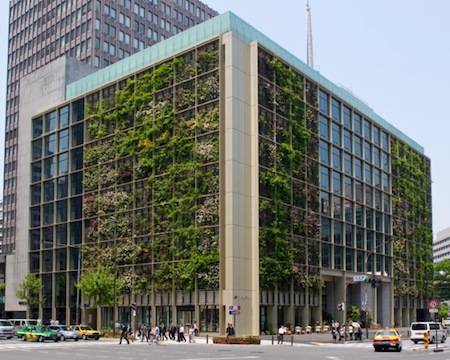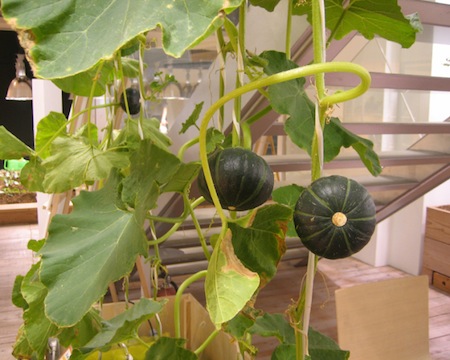Science Fiction
Dictionary
A B C D E F G H I J K L M N O P Q R S T U V W X Y Z
Pasona Office Building Is An Urban Farm

How much do you want to be green? At the offices of Pasona, a Tokyo agency, twenty percent of the space is devoted to growing fresh vegetables and other edible plants.

(Pasona building - livin' large)
... the urban farm—the largest in Japan, with a layout that architects around the world should be paying attention to—doesn’t just exist to produce fresh food for Pasona’s employees. With young Japanese citizens giving up agriculture for business in the city, Pasona and its architecture firm, Kono Designs, hope the lush surroundings will inspire urbanites, and give them a newfound appreciation for agriculture.The green areas use a combination of soil-based and hydroponic farming. One of the greatest challenges is balancing the climate needed for growing produce with temperatures that are more comfortable for humans. Some say this is the building’s greatest pitfall, with certain rooms repelling visitors. The main entrance, which sports a rice paddy, is a bit warmer, brighter, and moister than most people would prefer. Workers use a side entrance to avoid it.
I was going to use the Chlorella Plantation from Pohl and Kornbluth's 1952 novel The Space Merchants as an early example of an urban farm (which it is).
Update 27-Mar-2020:
End update.
However, take a look at this next photo.

(The plants are taking over!)
Apparently, some of the building spaces are a bit uncomfortable for business-suited humans, because the plants have taken over! I'm trying to think of examples (which I'm sure I've seen) that depict space ships at least partly taken over by plants.
Via QZ.
Scroll down for more stories in the same category. (Story submitted 8/19/2013)
Follow this kind of news @Technovelgy.| Email | RSS | Blog It | Stumble | del.icio.us | Digg | Reddit |
Would
you like to contribute a story tip?
It's easy:
Get the URL of the story, and the related sf author, and add
it here.
Comment/Join discussion ( 1 )
Related News Stories - (" Food ")
Thermostabilized Wet Meat Product (NASA Prototype)
There are no orbiting Michelin stars. Yet.
Edible Meat-Like Fungus Like Barbara Hambly's Slunch?
'It was almost unheard of for slunch to spread that fast...' - Barbara Hambly, 1985.
Holland Factory 3D Printing 500 Tons Of Steak Per Month
'...I don’t understand technical things — tell me, does it ever feel anything?" - Margaret St. Clair, 1955.
Robochef Robotic Food Prep
'No hand touched the food...' - Edgar Rice Burroughs, 1912.
Technovelgy (that's tech-novel-gee!) is devoted to the creative science inventions and ideas of sf authors. Look for the Invention Category that interests you, the Glossary, the Invention Timeline, or see what's New.
Science Fiction
Timeline
1600-1899
1900-1939
1940's 1950's
1960's 1970's
1980's 1990's
2000's 2010's
Current News
Bone-Building Drug Evenity Approved
'Compounds devised by the biochemists for the rapid building of bone...'
Secret Kill Switch Found In Yutong Buses
'The car faltered as the external command came to brake...'
Inmotion Electric Unicycle In Combat
'It is about the size and shape of a kitchen stool, gyro-stabilized...'
Grok Scores Best In Psychological Tests
'Try to find out how he ticks...'
PaXini Supersensitive Robot Fingers
'My fingers are not that sensitive...'
Congress Considers Automatic Emergency Braking, One Hundred Years Too Late
'The greatest problem of all was the elimination of the human element of braking together with its inevitable time lag.'
The Desert Ship Sailed In Imagination
'Across the ancient sea floor a dozen tall, blue-sailed Martian sand ships floated, like blue smoke.'
The Zapata Air Scooter Would Be Great In A Science Fiction Story
'Betty's slapdash style.'
Thermostabilized Wet Meat Product (NASA Prototype)
There are no orbiting Michelin stars. Yet.
Could Crystal Batteries Generate Power For Centuries?
'Power could be compressed thus into an inch-square cube of what looked like blue-white ice'
India Ponders Always-On Smartphone Location Tracking
'It is necessary... for your own protection.'
Amazon Will Send You Heinlein's Knockdown Cabin
'It's so light that you can set it up in five minutes by yourself...'
Is It Time To Forbid Human Driving?
'Heavy penalties... were to be applied to any one found driving manually-controlled machines.'
Replace The Smartphone With A Connected Edge Node For AI Inference
'Buy a Little Dingbat... electropen, wrist watch, pocketphone, pocket radio, billfold ... all in one.'
Artificial Skin For Robots Is Coming Right Along
'... an elastic, tinted material that had all the feel and appearance of human flesh and epidermis.'
Robot Guard Dog On Duty
I might also be thinking of K-9 from Doctor Who.
